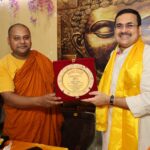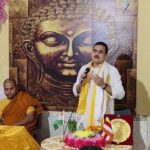The final battle
- By : Anirban Ganguly
- Category : Articles

On his death anniversary, as the Indian Tricolour flies uncontested in J&K, Dr Mookerjee’s triumph over Nehru in their final confrontation becomes irrefutable
In the early hours of June 23, 1953, around 2.30 am, Dr Syama Prasad Mookerjee died in detention at the state hospital in Srinagar. His illness, suppression of the news of his illness, the delay and lackadaisical attitude towards his treatment displayed by the Sheikh Abdullah government and his lonely death has moved generations to repeatedly ask questions over his sudden and mysterious end. The words of Dr Mookerjee’s grieving mother Jogmaya Devi come to mind. She had written:
“Death is inevitable. But death in detention — and detention without trial — is neither normal nor inevitable. Yet, such was the death of my son. Imprisoned by persons whose political activities he dared to oppose, surrounded by armed guards till his last moments in the hospital, far away from his near and dear ones, without even one familiar face within his last sight, my gallant son, met his tragic end. With what words on his lips, in whose presence, and under whose care and treatment did he depart — even I, his mother, it seems, shall never know.”
In her demand for justice from then Prime Minister Jawaharlal Nehru, Jogmaya Devi raised several questions, which Nehru never bothered to answer. ‘Am I to believe’, she wrote, ‘That in Free India to lead an opposition is a crime? And yet my son suffered detention till death, as a condemned criminal, with this difference that the criminal gets a trial, but for him, there was not even a show of trial.’ Her lament still rings in one’s ears, when one examines the sequence of events that unfolded leading to Dr Mookerjee’s detention and his sudden death. ‘It seems, malice and jealousy of persons in authority,’ she lamented, ‘armed by the people with unlimited powers, pursued him persistently, and a huge machine of organised injustice was set against him.’
Conspiracy it was, and Dr Mookerjee himself realised it once he was allowed to enter Jammu and Kashmir and then promptly arrested, his entry into the State was, in his own words, “facilitated” by officials of the Government of India, who must have surely been under political instruction to ensure that Dr Mookerjee entered the State. In a note found in his briefcase after his death, in which he had jotted down points in ‘connection with his application before the Kashmir High Court”, he states that there was a clear malafide on part of the Sheikh Abdullah Government and the Nehru Government, in detaining and imprisoning him in Kashmir. Pleading for the Court to intervene since there was a malafide behind the act of arresting him, Dr Mookerjee wrote:
“Conspiracy between the Govt. of India and J&K Govt. — the circumstances under which my entry was facilitated by Indian Officials.”
One of Dr Mookerjee’s closest political colleagues in the erstwhile Hindu Mahasabha, the one who was instrumental in his meeting with Veer Savarkar, barrister Nirmal Chandra (NC) Chatterjee (1895-1971), Member of Parliament from Hooghly in West Bengal in the first Lok Sabha, delivered one of the most scathing speeches on September 18, 1953, when the House discussed Dr Mookerjee’s death. On Dr Mookerjee’s written submission that it was a conspiracy between the Nehru Government and the Sheikh Abdullah Government, Chatterjee, arguing that the conspiracy charge was justified told the House, “Not only did the Government of India not arrest him for the infringement of the so-called permit system which that Government introduced — it did not detain him for the alleged violation of the permit system — but the District Magistrate of Gurdaspur actually escorted Dr Mookerjee and his party right up to the border, and it seems that he was pushed into the State of Jammu and Kashmir as a result of some understanding or some arrangement between the Government of India and the Government of Jammu and Kashmir State.’
If the Government of India was the permit-issuing authority and if Dr Mookerjee did not have a permit, why was he allowed to enter Jammu in the first place? Jana Sangh leader, Vaid Guru Dutt who was accompanying Dr Mookerjee, in his deposition, recalled how the District Magistrate of Gurdaspur, ‘offered help to procure conveyance’ for the party and Dr Mookerjee. One of the subordinate officers, in fact, gave a lift of some of the members of Dr Mookerjee’s party in his vehicle up to the Madhopur check-post on the border with Jammu. At the Madhopur check-post, the well-laid plot further unfolded, with the District Magistrate and his officers being present there and wishing the party a ‘good journey.’ “The driver of our jeep”, recalled Dutt, “had at that time complained that he had no permit to enter Jammu State. We demanded a permit from the District Magistrate. He stated that we should proceed and the permit would follow.”
So, in good faith Dr Mookerjee and the party proceeded, only to fall into the trap laid out by Nehru’s government on one side and Sheikh Abdullah’s on the other. “But when we had traversed half the Ravi Bridge”, Dutt stated, “Jammu police officers and a good many constables were found to be standing there and one Mr Aziz, Superintendent of Police, Kathua, informed Dr Mookerjee that he could not proceed further as his government had issued an order prohibiting his entry into Jammu and Kashmir State. A surprised Dr Mookerjee told him that he had been allowed by the Indian Government to go into the Jammu and Kashmir State and he would proceed to that place…” On this, the SP of Kathua, interestingly, was well prepared, he “produced another order from his pocket arresting him.”
The conspiracy thus was well planned, Nehru’s government allowed Dr Mookerjee to travel into Jammu even though he did not have a permit and the Government of India’s directive mandated that a permit was required, while the Sheikh Abdullah government arrested him because he had entered the State without a permit, even though, at the time Dr Mookerjee’s arrest, the J&K Government did not have the permit rule.
NC Chatterjee summed it up most movingly when he told Parliament, on September 18, that what “adds poignancy to the tragic death is that one of the greatest sons of India was robbed of his freedom, not by a Government run by alien usurpers, but by a Government which was manned by the children of the soil. The greatest tragedy was that he was kept as a prisoner behind the prison bars, without any trial and he was treated like an ordinary criminal despite his serious illness because he loved his motherland deeply and passionately and because he sought in his way to maintain, the unity of the country, and, if possible, to intensify and strengthen that unity and solidarity.”
Questions galore also remain on how Dr Mookerjee had died, questions which Rahul Gandhi and his political lineage have avoided answering, questions which the Congress has tried to brush aside. But as long as Dr Mookerjee’s legacy lasts, these are questions that will keep haunting them. Jogmaya Devi’s letters to Nehru, pleading for an enquiry, Nehru’s refusal to order it, Sheikh Abdullah’s obfuscations of events leading to Dr Mookerjee’s death, the high doses of a particular medicine, which were injected into Dr Mookerjee, despite knowing that he was allergic to them, the white powder that was being given to him, his missing diary and, finally, the matter of why an obstinate, self-obsessed, arrogant and scheming Nehru not order his release even after knowing that Dr Mookerjee’s health was deteriorating, are issues that still hang.
NC Chatterjee perhaps echoed the voice of the majority, when he cautioned a stunned and silent House, that “the greatest menace to democracy is the feeling that a political opponent of the Government can be liquidated in prison when he is held in detention without trial.” Nehru, in fact, had just done that.
For the first time in 67 years after his death, Dr Mookerjee’s death anniversary this year (June 23, 2020) and birth anniversary (July 6, 2020) will be observed and celebrated in an India freed of the vexatious and divisive Article 370, in a Jammu and Kashmir in which only one flag flutters, the Indian Tricolour, reminding us of Dr Mookerjee’s words, uttered decades ago amid the struggle for the integration of Kashmir, “It is the question of one flag for the whole of India, India that includes Kashmir.” Prime Minister Narendra Modi’s new vision for the region is a tribute to Dr Mookerjee’s aspirations and hopes for an integrated India.
In the final analysis, on Kashmir, Nehru has lost and Dr Mookerjee has triumphed. He has emerged victorious from his final battle.

















